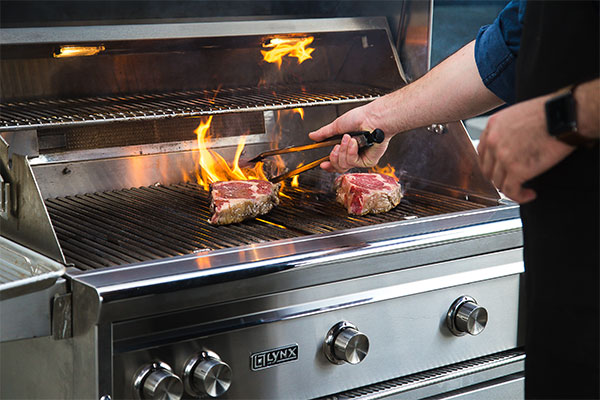Gas grills have gotten a bad rap over the years. Many BBQ purists suggest that if you’re not grilling with charcoal or wood, you’re not really grilling at all. To that I say, “Whatevs!” I might even include the eye roll emoji that my 12-year-old daughter sends me when I text her about her chores.
All jokes aside, while I often use charcoal as a source of fuel, great food can be produced using a gas grill. For many outdoor cooking enthusiasts, charcoal just isn’t an option. That could be because of a cook’s living situation, time constraints, or comfort level. Given that 58% of grills sold last year were gas—as opposed to only 40% charcoal—I believe it’s clear many outdoor cooks fall into one of those categories.
The Basics
Gas or charcoal… what’s the difference? The fundamental difference is pretty obvious: liquid propane is the most common heat source for gas grills whereas charcoal models allow cooks to use briquettes or lump hardwood charcoal. There are, of course, hybrid models with gas burners on only one side of the grill and room for charcoal on the other side. Some models even use gas burners to ignite charcoal. But, at the end of the day, a cook is usually forced to pick one heat source over the other.
Advantages of Cooking with Gas
Most people will tell you the main advantage to using a gas grill is convenience. A gas grill ignites and heats up quicker than a charcoal model, so for those with little time this is often a big bonus. In addition to speedy heating, gas grills cool down much faster than their charcoal counterparts; the difference is even more pronounced compared to ceramic cookers. This means that a gas grill will be ready to cover and put to bed after a cook much sooner—no more waiting in the dark for the grill to cool down! Speaking of saving time, the clean-up with gas is much simpler because there’s no charcoal or ash to contend with after your cook.
Adding to the convenience of gas is the ease with which temperature can be controlled. With the turn of a knob you have more or less heat; on a charcoal unit heat is controlled by airflow. While managing the airflow is pretty easy (once you get the hang of it), it does require more attention that turning a knob.
For those with an eye on the bottom line, gas grills are also cheaper to operate. You’ll spend more on fuel trying to run a charcoal grill for any given length of time than you would with a grill running on liquid propane.
Safety is another benefit to gas. While charcoal is a safe cooking fuel, some home owners’ associations or apartment complexes don’t allow charcoal grilling because of potential hazards from loose embers or ash. Working with charcoal (or gas) requires attention and care at all times!
Finally, if you’ve never used charcoal it may be intimidating or a bit outside of your comfort zone. There’s no shame in that; plenty of people have never lit a pile of charcoal in their life. Don’t let the diehards shame you into something you’re not comfortable using.
Drawbacks of Gas Cooking
There are plenty of reasons you may elect to use a gas grill over a charcoal model, but there are some drawbacks as well. For example, getting the natural flavor from wood and charcoal is challenging on a gas grill. There are ways to achieve a hint of smoke when cooking a steak or burger over gas, but you won’t get the deep smoke ring and bark on a large cut of meat or rack of ribs like you would if using a charcoal cooker or offset smoker during a several hour cook.
Although we established above that gas is a cheaper fuel than charcoal, price can be a bit of a hurdle when finding a reliable grill to purchase. There is a substantial price difference between a good gas grill and a good charcoal grill. And once you start comparing premium gas grills to premium charcoal grills, the difference gets even bigger.
What makes for a “good” gas grill could be an entire post on its own, but I wouldn’t recommend anything with less than 2 (but preferably 3) burners. Having multiple burners will allow you to create the direct and indirect heating needed for two-zone cooking. As an additional piece of advice: don’t expect one of the el cheapo units from a big box store to last more than one or two grilling seasons. They are cheap for a reason, and remember this – cheap is expensive. If initial cost is an issue, charcoal may be the way to go for you.
Next, achieving the right temperature for certain cooking techniques may not be possible on your gas grill. For some (but not all) high end infrared gas grills, getting the temperature down to the mid to lower 200 degree range for low-and-slow cooks is a real challenge. Most infrared units are designed to with one goal in mind: get very hot, very fast. Conversely, on the entry-level gas grills (even at the HIGH setting) you can’t get the intense temperatures required for a perfect crust on a steak, they simply don’t get hot enough.
Finally (and this is subjective), managing the fire on a charcoal model is just plain therapeutic for some people. It’s almost an art form, knowing the grill and managing the temperature manually through slight adjustments of the vents or addition of fuel. Think of this as akin to the love affair some drivers have with manual transmission vehicles. An automatic offers plenty of benefits and is certainly easier to operate, yet some enthusiasts insist on “rowing their own” gears.
If the advantages of gas have you sold, be sure to come back for Now You’re Cooking with Gas – Part 2. I’ll be sharing my favorite tips and tricks for getting the best flavor and performance from your gas grill.


